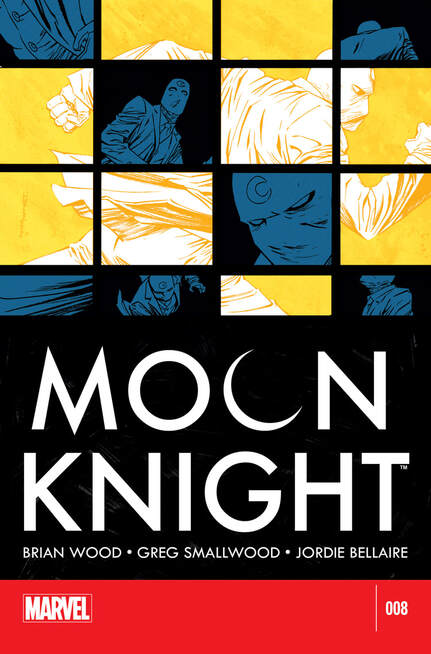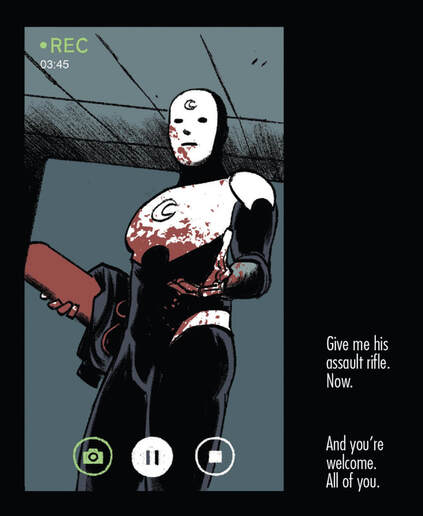Written by Joel T. Lewis  In celebration of the impending release of the Moon Knight series premiering March 30th on Disney Plus I’m doing a deep dive on some of the lesser explored corners of the Moonie Mythos. First up is an experimental and chilling issue first released in December of 2014, issue number 8 “Live” written by Brian Wood, and art by Greg Smallwood. Responding to a suicide bomber seizing control of the One World Trade Center building in New York, Moon Knight coordinates with Detective Flint to scale the skyscraper and liberate the hostages, imprisoned high above the police presence and media frenzy below. We follow Moon Knight through the lenses of camera phones, local news coverage, scarab spy drones, and security camera footage as he coordinates his dissociative identity disorder alter egos to infiltrate and neutralize the hostage situation. Transitioning from affable negotiator Steven Grant to the terrifyingly efficient brutality of Jake Lockley this issue explores the potential strategic dominance Moon Knight is capable of, provided he can get his alters to cooperate. While the completion of the mission rapidly spirals away from the civility of the rules of engagement, Marc is self-aware enough to tell Flint to contact his therapist. This signals his own instability and desperation for an anchor but also puts his therapist, whose motivations are in question at this point in the run, on Flint's radar as he (Marc) suspects her to not have his best interests at heart. In a series famed for the incredible artwork of Declan Shalvey (who adapted the now iconic Mr. Knight design from its first introduction by artist Michael Lark in issue 19 of 2010’s Secret Avengers series), Greg Smallwood (who would become the series regular artist for Jeff Lemire’s 2016 run) plays with form and expectation with his interpretation of Moon Knight in issue 8. “Live” is a brilliant, shocking issue which challenges the conventions of comic book art, scripting, and lettering by emulating mediums of modern technology. Smartphone screens, texted dialogue and narration, and security surveillance footage stand in for the traditional panel and speech bubble staples and the effect is stunning. This an issue that pushes the boundaries of comic book storytelling which in many ways is a Moon Knight tradition. Harkening back to the brilliant evolution of Bill Sienkiewicz’s art in the first Moon Knight series in 1980, (specifically issues 23-26) this issue uses every ounce of its creators’ ingenuity to capture the Jet and Silver Avenger from unique angles (pun intended).  The haunting images of a cloak-less Moon Knight, stalking the darkened cubicle aisles of the high-rise he’s scaled are eerie, casting our hero as an enigmatically sinister crash test dummy instead of righteous savior. The uncanny valley at work is two-fold: the inhuman, vacant expression of Marc’s mask fails at appearing human, but it also fails at appearing to be Moon Knight. The design is terrifying, and I wouldn’t be surprised to see it reprised one day as a villain’s chosen costume (perhaps a Moon Jester to trade blows with our Moon Knight?). Moon Knight’s madness and brutality are at their most infamous and extreme in the 2006 Huston and Finch run “From the Bottom” in which we see a vicious fist of Khonshu carving crescent moons into the foreheads of his criminal victims, and most famously of all cutting the face off his oldest enemy Raoul Bushman and wearing it. This issue has to become part of that conversation. The rage, the cold tactical planning and coordination of Marc’s alters (alternate identities) in this issue, and the casual menace of Jake Lockley’s crippling and later bloody murder of the would-be suicide bomber plunge this characterization of Moon Knight into its darkest iteration to date. This is an unpredictable, competent, and brutal individual and if you have the misfortune to meet him there’s a good chance you’ll have to fight to stay a-“Live”.
0 Comments
Leave a Reply. |
Archives
May 2024
|
|
© 2012-2025, Nerds That Geek LLC.
All Rights Reserved. |
uWeb Hosting by FatCow

